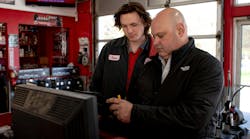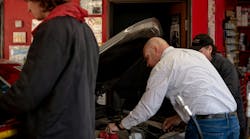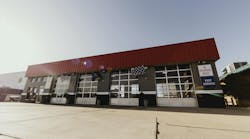The name of my column is “Making it Happen,” and that is exactly how consistently successful presentations unfold — someone makes them happen. A successfully planned and executed presentation is no accident. Certain techniques and procedures will allow you to maximize your success with each potential customer.
There are five basic but simple-to-correct mistakes that are quite common in just about any failed presentation, and if you think you may not be getting the results you want from your customers, you are probably guilty of one or more of the following “Presentation Killers,” presented here in reverse order:
5. Boring the Customer
A lifeless and unenthusiastic presentation bores your customer. They don’t want to listen to anyone drone on about filters, fluids and flushes in a monotonous, robotic voice. You must put some life and vitality into your presentation; give it some spark! Give your customers a reason to want to listen to you. Be interesting.You may be asking, “How do I make myself interesting to my customer?” There are several basic techniques that you can employ that will increase your chances of holding your customer’s attention.
Smile! This is the oldest and most-often repeated tip of a winning sales presentation, and there is a reason why — it works!First of all, don’t just stand there like a statue when you talk to them. Use your hands and shift your stance around as you proceed through your presentation. If you have a clipboard with the vehicle’s information on it, hold it in your hands and refer to it often. Not only does this give your customer a sense of verification of the things you are telling them, it also keeps them guessing what you will say next.
Nod your head subtly while you speak to your customer, especially when they may be answering any question you may have asked them. By showing agreement with the head nod, your customer feels you are actually listening to them, which encourages confidence in them towards you and the things you are telling them.
And most of all: Smile! This is the oldest and most-often repeated tip of a winning sales presentation, and there is a reason why — it works! Look your customer in the eye and smile when you speak to them. Nobody wants to hold a conversation with a depressed and negative-sounding technician!
4. No Benefits
I can’t tell you how many hundreds of presentations I have listened to over the years where the technician never told the customer any of the actual benefits of purchasing the service or item that he was recommending. There seems to be a couple of different “levels” of this mistake: Those who simply don’t give the customer any beneficial reason at all why they should consider the recommendation, and then those who give a lot of features for the service or item, but no clear benefits.You have told the customer how it betters the vehicle, but you haven’t told them how it is beneficial to them personally.Let’s be clear, features and benefits are NOT the same thing. The feature of any item or service is a description of what it is, what the service entails, how it is performed and how it helps the vehicle.
The benefit of a service or item is exactly what it does that is beneficial to the customer. This is an extremely important distinction, and one that even seasoned salespersons in all fields get wrong.
Most of the time, a technician who makes this mistake is unaware he is doing so, for he assumes that the customer should obviously know what the benefit of the service is and therefore he just simply does not tell them.
You have told the customer how it betters the vehicle, but you haven’t told them how it is beneficial to them personally. What does it do for the customer (not the vehicle)? A transmission flush will help keep the transmission shifting properly. It will help prevent premature failure and it may prevent the customer from having a big repair bill down the road. These are just a few of the benefits that a customer may derive from a transmission flush.
It is easy to think of benefits: Just be sure and tell them to your customers!
Next on the list of “killers’ is a perennial mistake and a bad habit that many veteran technicians have been making for years…
3. Not Involving the Customer in the Decision-Making Process
You are a trained, professional technician. Customers can tell that by the uniform you wear. They can tell that by specific tools you use, and by the industry jargon and vehicle- specific information that you share with them. You may even have some specific service- qualified certificates displayed for them to see, and maybe even some certification patches on your uniform sleeve. Good job… you go, tiger!Unfortunately, in the fast lube arena, we do not deal strictly in reality. We deal in perceptions — customers’ perceptions, to be exact.All that is well and good, but in the customer’s view, none of that in any way gives you the ability or the right to simply tell them what they need or to tell them what they should do. The reality is that as a trained technician you should be able to discern exactly what services and parts a customer’s vehicle needs with very little input from the customer, right?
Like all of you, I know that I can determine by mileage and condition when an air filter is ready to be replaced, and I can tell when a windshield wiper is due for the trashcan. And like most of you, I can also read the factory mileage recommendations for a fuel filter or coolant system and make an accurate determination of when those systems are due for service. The customer is really not even needed, or maybe only marginally for us to make those determinations. That is the reality of the situation.
Unfortunately, in the fast lube arena, we do not deal strictly in reality. We deal in perceptions — customers’ perceptions, to be exact.
When you visit your family doctor for a checkup, what happens? Typically the nurse will escort you to the examination room and perform a series of checks on you: blood pressure, heart rate, look in your eyes, ears and throat, maybe even test your reflexes with that little hammer. She will then write all the results of her findings down in your chart and tell you that the doctor will be with you shortly as she leaves you all alone in the room, giving you time to rifle through the drawers looking for the box of latex gloves.
When the doctor finally but inevitably comes into the room, he is carrying the very same chart that the nurse just filled out a few moments before. After some small talk and a few questions — usually the same questions the nurse just asked you — the doctor will give you his prognosis, any recommendations and maybe even a prescription or two. A few minutes later and you are on your way.
The reality of that situation is that the doctor was asking you questions and making a little small talk all for the sake of bedside manner. Any recommendations or prescriptions he may have given you were based almost certainly on nothing other than what was in the chart. His years of medical school have taught him how to read, comprehend and recommend based on those findings. His bedside manner is only to allow the patient to relax and listen to what he has to say.
Your “carside manner” is much the same. How you interact with your customer is what is going to allow you to get that information to your customers in an effective manner. Otherwise, they simply won’t listen to you.
The main technique to having an effective “carside manner” is to talk to your customers and not at them. Simply telling your customers facts and information is a one-sided and boring relationship. Get the customer involved in the conversation by asking some questions. Then, listen carefully to the answer. Don’t assume you know what they are going to say.
The main technique to having an effective “carside manner” is to talk to your customers and not at them.So, don’t say, “I checked your transmission fluid, and GM recommends that you change it at 50,000 miles. You now have 76,000 miles so you need to get that serviced.”
Instead, get the customer involved like this, “I checked your transmission fluid, and GM recommends that you change it at 50,000 miles, and I can see that you now have 76,000 miles on your car. How long has it been since you have had that service performed?” This simple question gets the customer involved in the conversation, and in the process of determining what is best for his or her vehicle.
Master your “carside manner” by talking to your customers, not at them.
2. Too Much Information
A well-trained and educated technician has a lot of knowledge and technical information that he can use when necessary. The truth is that it is rarely necessary to use as much product knowledge as some techs do.Think of your product knowledge the same way you would think of the spices in your kitchen that you use to cook with. I would guess that the top three spices in most kitchens would be salt, pepper and garlic. A little goes a long way with this stuff, and just a sprinkling will enhance the natural flavors of the food and give it an overall better taste.
Well, if a little is good, then a whole lot more must be better, right? Try dumping an entire shakerful of salt on your next meal and see if it tastes better.
Product knowledge is the same way. A little goes a long way. Give your customer just a little taste of it, and it will enhance your entire presentation. Dump every morsel of knowledge that you know about a particular service or item on your customer and they will just find it uninteresting.
’Nuff said.
And the number-one, all-time mistake that techs make in their presentations is…
1. Not “Closing” Properly
To properly “close” a presentation, you must ask the customer if they want to do the service today. The key word here is “ask,” as in it must be a question.A proper close must be a direct question, never a statement.Any presentation that does not end with you asking the customer if they want to do whatever it is you are recommending today is doomed for failure. Hinting around and suggesting is not the same as asking. A proper close must be a direct question, never a statement.
It is just that simple.
“Closing” does not mean being rude and asking harshly, but rather being friendly, though direct. Whatever level of success you may be having (and you may be one of the best in your shop), you will only become more effective if you consistently close properly.
There you have it, the top five blunders that happen every day in lube shops across the country.
Along with correcting any of the above mistakes, the secrets to a great presentation are to make as few mistakes as possible, keep it simple (I can’t stress this enough) and to have fun.
See ya’ next month!





